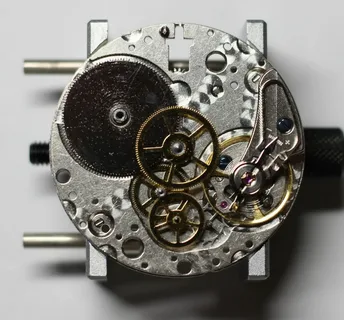When it comes to Swiss watchmaking, precision and craftsmanship are paramount. The ETA 1301 movement is a prime example of these qualities, and understanding how it works is essential for watch enthusiasts and collectors. One of the most helpful ways to explore this intricate mechanism is through an exploded view, which reveals how each component of the movement fits together. This article delves into the exploded view of the ETA 1301 watch movement, offering a closer look at its parts and how they interact to power a reliable timepiece.
What is the ETA 1301 Movement?
The ETA 1301 is a mechanical movement created by the Swiss movement manufacturer ETA SA. It’s a compact, robust, and reliable movement, primarily used in mid-range watches due to its affordability and precision. The ETA 1301 features a time-only function, meaning it displays the hour, minute, and second hands without additional complications such as a date window or chronograph.
This manual-wind movement is designed for longevity and durability, making it a favorite for watchmakers who seek a dependable workhorse. In essence, it’s the ideal movement for those who appreciate traditional mechanical watches and the beauty of hand-winding.
Exploded View: What Does it Reveal?
An exploded view is a technical illustration that disassembles a complex mechanism like the ETA 1301 watch movement, showing each part in a 3D format as if they were “exploding” outward. This helps viewers understand how the components fit together, their function, and their relationship to one another. When you look at the exploded view of the ETA 1301 movement, you can expect to see various crucial elements and their roles in keeping time.
Let’s break down the major components found in the exploded view:
1. The Barrel and Mainspring
At the heart of any mechanical watch, the barrel houses the mainspring. This tightly coiled spring is wound manually, storing energy that powers the movement. As the mainspring unwinds, it releases energy that drives the other components of the movement, such as the gear train and escapement.
2. The Gear Train
The gear train is responsible for transmitting the energy from the barrel to the hands. In an exploded view of the ETA 1301, you’ll see the gears arranged in a series of different sizes and configurations. These gears reduce the speed of the energy and ensure that it moves at a consistent pace. From the main wheel to the minute and hour wheels, each gear is meticulously designed to prevent friction and wear, ensuring smooth operation.
3. The Escapement
The escapement plays a crucial role in regulating the flow of energy. The ETA 1301 features a Swiss lever escapement, which consists of the pallet fork and escape wheel. This system allows the gear train to move in precise increments, giving the watch its ticking sound and controlling the flow of power to the balance wheel.
4. The Balance Wheel and Hairspring
The balance wheel, often referred to as the “heartbeat” of the movement, is crucial for timekeeping accuracy. Paired with the hairspring (a tiny spiral spring), it oscillates back and forth at a precise rate. In the exploded view, you can see how these two components work together to control the timing of the watch. The balance wheel’s regular oscillations help divide time into consistent intervals, which the hands then display on the dial.
5. The Pallet Fork
The pallet fork is a key part of the escapement mechanism, interacting with the escape wheel to regulate the release of energy. It works by alternately locking and unlocking the teeth of the escape wheel, transferring energy to the balance wheel. In the exploded view, you’ll notice the delicate design of this tiny yet vital part.
6. The Hands
The hands—hour, minute, and second—are the most visible components of the watch. The energy from the gear train is transferred to these hands, making them move to indicate the time. While relatively simple in design, they require precise movement to maintain accurate timekeeping.
7. The Rotor (If Automatic)
Although the ETA 1301 is a manual-wind movement, many of ETA’s other movements feature an automatic winding system that includes a rotor. If you were to explore an exploded view of an automatic ETA movement, you would see the rotor—a semicircular weight that moves with the motion of the wearer’s wrist. This motion winds the mainspring, keeping the watch running without manual winding.
The Significance of the Exploded View for Watch Enthusiasts
An exploded view offers valuable insight into the inner workings of a timepiece. For collectors, horology enthusiasts, and those passionate about mechanical watches, this visual representation makes it easier to appreciate the complexity and craftsmanship involved in the creation of a high-quality movement like the ETA 1301.
It allows individuals to recognize the precision of each component and how even the smallest part contributes to the movement’s overall function. For watchmakers, this exploded view can serve as an invaluable tool for assembly, repair, and troubleshooting, as it shows exactly where each component fits and how they interconnect.
Conclusion
The ETA 1301 is an exemplary manual-wind movement that combines reliability, accuracy, and traditional Swiss craftsmanship. By analyzing the exploded view of this watch movement, we gain a deeper appreciation for the mechanical genius behind the ticking seconds. From the mainspring’s energy release to the balance wheel’s oscillations, each part of the ETA 1301 movement plays a pivotal role in ensuring the watch performs accurately and efficiently.
Whether you’re a seasoned watch enthusiast or a newcomer to horology, understanding the exploded view of a movement like the ETA 1301 allows you to unlock the mysteries of mechanical watchmaking and witness firsthand the ingenuity of Swiss craftsmanship.
